Add this eBook to your basket to receive access to all 336 records. Our indexes include entries for the spelling merriman. In the period you have requested, we have the following 336 records (displaying 241 to 250): These sample scans are from the original record. You will get scans of the full pages or articles where the surname you searched for has been found. Your web browser may prevent the sample windows from opening; in this case please change your browser settings to allow pop-up windows from this site. Fellows of the British Gynaecological Society
(1891)
The alphabetical list of fellows of the British Gynaecological Society gives year of election, full name (surname first), qualifications, and address. The abbreviations used are: C., member of council; F. F., foundation fellow (i.e., since 1884); Hon. Loc. Sec., honorary local secretary; Hon. Sec., honorary secretary; H.P., honorary president; L., life fellow; Libr., librarian; Pres., president; Treas., treasurer; V.P., vice-president. | Sample scan, click to enlarge

| Boys entering Sedbergh School
(1892)
B. Wilson prepared this edition of the register of the Grammar School at Sedbergh in the West Riding of Yorkshire, published in 1895. Sedbergh school had three exhibitions at St John's College, Cambridge, and for the earliest years little more could be found about the pupils at the school than was recorded at St John's or other colleges. In 1700-1706 the first material from Sedbergh appears, but no more than lists of surnames. From 1746 onwards full names, or surnames and initials, are found for those boys who did not continue to university. It is only from 1820 onwards that the school register starts to give detail: month of entry, age, birthplace, and month of leaving. From then onwards Wilson was able to add more and more biographical detail, except, of course, for those boys in 1895 still at the school or with their careers yet ahead of them. | Sample scan, click to enlarge
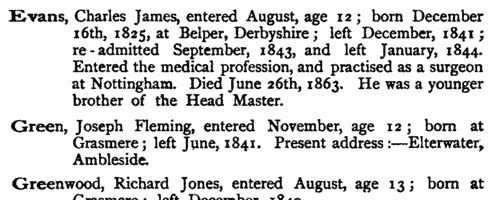
| Boys entering Epsom College
(1893)
The Royal Medical Benevolent College at Epsom in Surrey was founded in 1853 for the orphans of the medical profession, and evolved to become a public school still largely catering for sons of doctors and surgeons. In 1955 this register of pupils, from 1855 to 1954, edited by T. R. Thomson, was published. The sample scan is from 1880. The entries are arranged alphabetically by surname under year of entrance to the school; surname first (in bold), christian names, and then (in most cases), the father's name, occupation and address: then the boy's year of birth (b.), year of leaving (l.), occupation, and, where known, year of death (d.). From 1880 onwards the house to which the boy belonged is also indicated: the boarding houses were Carr (C.), Forest (F.), Granville (G.), Holman (H.), Propert (P.) and Wilson (W.); and Crawfurd (Cr.), Hart Smith (H. S.) and Rosebery (R.) are the houses for day scholars. This is the index to the year 1893, when the Reverend Thomas Northmore Hart-Smith was headmaster. | Sample scan, click to enlarge

| Boys entering Uppingham School
(1894)
The public school at Uppingham in Rutland was founded by Archdeacon Johnson in 1584. A roll of scholars from 1824 to 1905 was edited by J. P. Graham, and published in 1906. This was a revision and updating of an 1894 edition of the roll, the great bulk of the work having been done by Mrs Mullins. The roll is arranged by year, and within each year by term of entrance, and then alphabetically by surname within each term. Each boy's name is given, surname first, with an asterisk where known (in 1906) to have died. Then there is month and year of birth, father's name (most often just surname and initials) and address (at entrance). Where the boy represented the school at Rugby football (XV) or cricket (XI), that is indicated. After the month and year of leaving the school, there is a brief summary of achievements in later life, and, where known, address as in 1906. From 1875 onwards the house within the school is also noted, with these abbreviations: A., Mr Constable's House; B., Brooklands; C., West Bank; E., Mr J. Gale Thring's House; F., Fircroft; Fgh., Farleigh; H., Highfield; L., The Lodge; L. H., Lorne House; M., Meadhurst; N., The Hall; R., Redgate; R. H., Red House; S., School House; and W. D., West Deyne. | Sample scan, click to enlarge
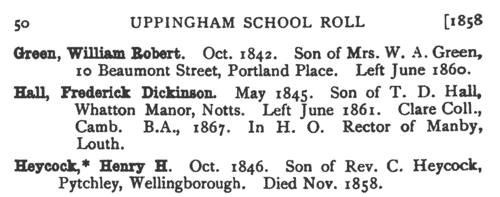
| Wimbledon schoolgirls and schoolmistresses
(1894)
Wimbledon High School produced a yearly magazine, issued in December, starting in 1889. Each issue contained general school news, sporting and scholastic results, essays, reports from the school societies (circles and clubs) and news of old girls, with their marriages, births of their children (giving both maiden and married surnames), and deaths. The old girls were organized into what was called the Wimbledon High School Union (W. H. S. U.) and there is news of the Union's doings and of new recruits - the school was opened in 1880, nine years before the Union was formed, and some girls had lost contact. | Sample scan, click to enlarge
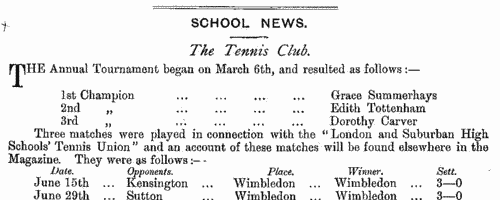
| Residents of Surrey
(1895)
Kelly's Directory of Surrey includes this alphabetical Court Directory, listing private residents in the county. In fact, this listing is a little more comprehensive than the main directory, in that it includes residents of some London suburbs that, although in the county of Surrey, are not included in the Surrey directory. Residents are listed surname first, then christian name or initials, and postal address. | Sample scan, click to enlarge

| Wimbledon schoolgirls and schoolmistresses
(1895)
Wimbledon High School produced a yearly magazine, issued in December, starting in 1889. Each issue contained general school news, sporting and scholastic results, essays, reports from the school societies (circles and clubs) and news of old girls, with their marriages, births of their children (giving both maiden and married surnames), and deaths. The old girls were organized into what was called the Wimbledon High School Union (W. H. S. U.) and there is news of the Union's doings and of new recruits - the school was opened in 1880, nine years before the Union was formed, and some girls had lost contact. | Sample scan, click to enlarge
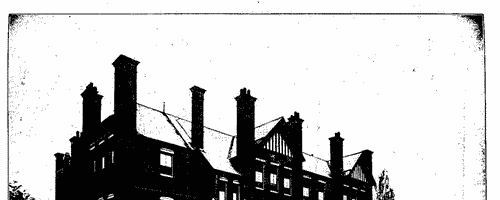
| Wimbledon schoolgirls and schoolmistresses
(1896)
Wimbledon High School produced a yearly magazine, issued in December, starting in 1889. Each issue contained general school news, sporting and scholastic results, essays, reports from the school societies (circles and clubs) and news of old girls, with their marriages, births of their children (giving both maiden and married surnames), and deaths. The old girls were organized into what was called the Wimbledon High School Union (W. H. S. U.) and there is news of the Union's activities. | Sample scan, click to enlarge

| Wimbledon schoolgirls and schoolmistresses
(1897)
Wimbledon High School produced a yearly magazine, issued in December, starting in 1889. Each issue contained general school news, sporting and scholastic results, essays, reports from the school societies (circles and clubs) and news of old girls, with their marriages, births of their children (giving both maiden and married surnames), and deaths. The old girls were organized into what was called the Wimbledon High School Union (W. H. S. U.) and there is news of the Union's activities. | Sample scan, click to enlarge
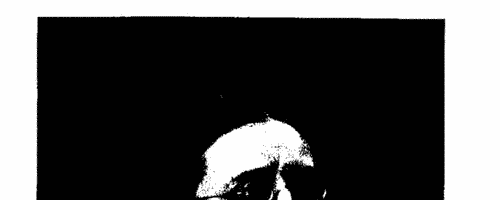
| Officers of the Royal Navy and the Royal Marines
(1898)
The Navy List, published by Authority, corrected to 18 December 1898, has this list of the officers on the Active List of the Royal Navy and the Royal Marines. Each officer's surname, christian name, and any middle initial(s) is given; with rank, date of seniority in that rank, and 'where serving', the last being the number of his ship. The ranks are: A, Admiral; A E, Assistant Engineer; A F, Admiral of the Fleet; A P, Assistant Paymaster; Art E, Artificer Engineer; As Ck, Assistant Clerk; B, Boatswain; Bandr, Bandmaster Royal Marines; C, Captain; Car, Carpenter; Ch, Chaplain; Ch B, Chief Boatswain; Ch Cr, Chief Carpenter; Ch E, Chief Engineer; Ch Gr, Chief Gunner; Ch P; Paymaster-in-Chief; Ck, Clerk; Cr, Commander; D I H, Deputy Inspector-General of Hospitals and Fleets; E, Engineer; E Ins, Inspector of Machinery; F E, Fleet Engineer; F P, Fleet Paymaster; F S, Fleet Surgeon; Gr, Gunner; H Sch, Head Schoolmaster; I H, Inspector-General of Hospitals and Fleets; L, Lieutenant; Mid, Midshipman; N C, Naval Cadet; N I, Naval Instructor; P, Paymaster; R A, Rear Admiral; S, Surgeon; S C, Staff-Captain; S Cr, Staff Commander; S E, Staff Engineer; S L, Sub-Lieutenant; S P, Staff Paymaster; S S, Staff Surgeon; Schm, Schoolmaster Royal Marines; St Ma, Sergeant Major Royal Marines; V A, Vice Admiral; W O, Warrant Officer Royal Marines. The column 'Where serving' also may have these abbreviations: AdC, Aide-de-Camp to the Queen; AO, Clerk to Secretary to a Flag Officer; CG, Coast Guard; CGP, Coast Guard Pension; DY, Dock Yard; GH, Greenwich Hospital; GHP, Greenwich Hospital Pension; GSP, Good Service Pension; NH, Naval Hospital; NID, Naval Intelligence Department; NP, Naval Pension (late Out-Pension of Greenwich Hospital); PW, Pension for Wounds; Sec, Secretary to a Flag Officer; TP, Travers Pension; TS, In the Transport Service; VY, Victualling Yard.
| Sample scan, click to enlarge
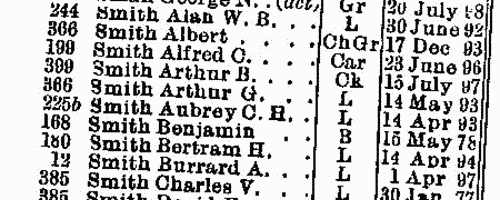
|
Research your ancestry, family history, genealogy and one-name study by direct access to original records and archives indexed by surname.
|











